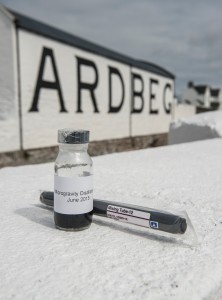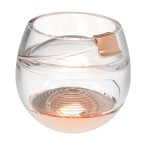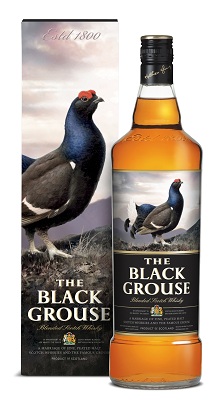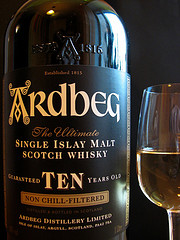In the last few weeks, there’s been a lot of news involving scotch and space, the final frontier.
Some of it was fluffy, some of it was legit, but it’s interesting how these stories clustered together.
The two that I found were more on the legit end were Ardbeg’s results from sending new make into space and Ballantine’s Space Glass.
Ardbeg’s Space Experiment

Courtesy of Ardbeg
Those vials made the trip back home and were compared with control vials left on Earth. Ardbeg’s Director of Distilling and Whisky Creation, Dr. Bill Lumsden, analyzed the results and discovered that the maturation was different when not subjected to gravity. Different flavors (ratios of wood extractive compounds from the barrel shards) just because it was in space. It means there are more levers to pull in making more distinctive single malts and kind of fun to see it play out.
OK so that’s the level of detail you probably have seen written about in most mainstream press – at this point I would’ve said “ehhh nice marketing move Ardbeg.”
There’s a lot more to it, they performed three tests – gas chromatography (GC), gas chromatography-mass spectrometry (GCMS), and high pressure liquid chromatography (HPLC).
GC measures key volatile compounds of alcohols, aldehydes, ketones, and fatty acid esters. For this, they found the same compounds in both the Earth and the Space samples.
The GCMS is a more serious version of GC and they discovered that one phenolic compound was much lower in the space samples.
And HPLC measures phenolic compounds and wood extractives, where they saw the biggest difference. With wood extractives, there are some compounds that come out of the wood easily and some that are harder. They discovered that without gravity, the easier to extract compounds were less prevalent than in the Earth sample. Gravity was a factor. Space whisky just didn’t get as much of the easy to get wood extractives.
Ballantine’s Space Glass
 Ballantine designed a glass that will let you enjoy your whisky in space.
Ballantine designed a glass that will let you enjoy your whisky in space.
At first glance, it sounds soooooo gimmicky. I mean a space glass? Really?
But as you read about it, it’s kind of cool. No doubt it’s gimmicky in the sense that you’re not going into space so you’re not going to need a space glass.
But… it’s also a really fun story because they didn’t just slap “Space Glass” on a regular glass, like Frozen’s been slapped on everything. (OK a Frozen glass with Elsa would be truly gimmicky).
It’s a James Parr designed 3D printed plastic with a metal base that contains a one-way valve and a 10kg pull magnet. I’d go into all the different parts of the design but I’d rather you take five minutes to watch this video from the designer himself.
Not gonna lie, I’d give it a try. 🙂

 How many people are familiar with Johnnie Walker? Practically everyone who has had whisky, and even many who haven’t, are familiar with the rainbow of colors that make up Johnnie Walker. Most have heard of Johnnie Walker Red, Black, Blue, and even Green (though
How many people are familiar with Johnnie Walker? Practically everyone who has had whisky, and even many who haven’t, are familiar with the rainbow of colors that make up Johnnie Walker. Most have heard of Johnnie Walker Red, Black, Blue, and even Green (though 